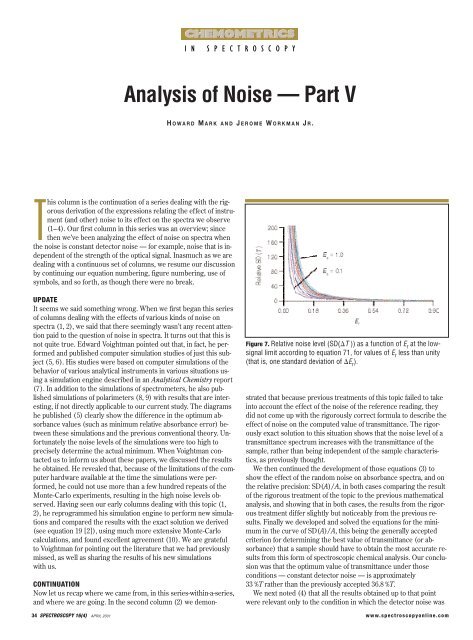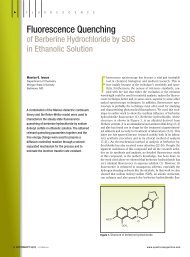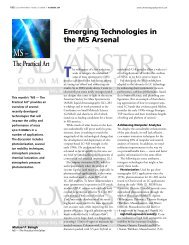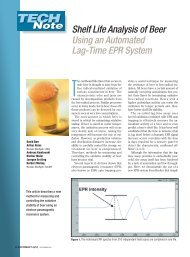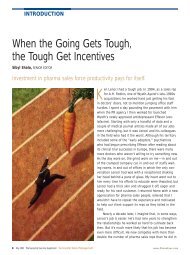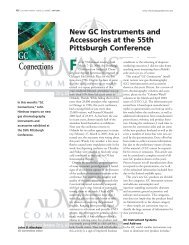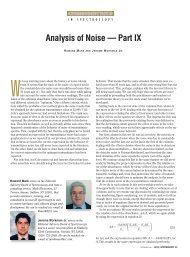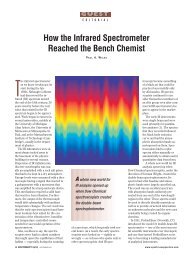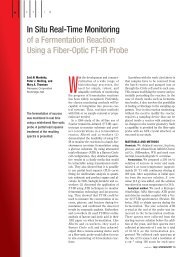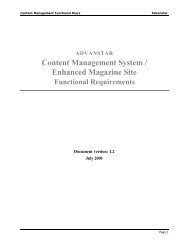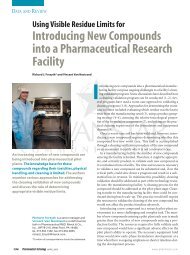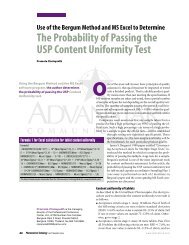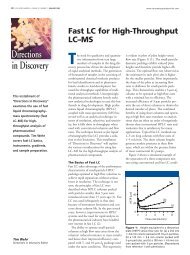Analysis of Noise â Part V - Spectroscopy
Analysis of Noise â Part V - Spectroscopy
Analysis of Noise â Part V - Spectroscopy
Create successful ePaper yourself
Turn your PDF publications into a flip-book with our unique Google optimized e-Paper software.
I N S P E C T R O S C O P Y<br />
<strong>Analysis</strong> <strong>of</strong> <strong>Noise</strong> — <strong>Part</strong> V<br />
H OWARD M ARK AND J EROME W ORKMAN J R .<br />
This column is the continuation <strong>of</strong> a series dealing with the rigorous<br />
derivation <strong>of</strong> the expressions relating the effect <strong>of</strong> instrument<br />
(and other) noise to its effect on the spectra we observe<br />
(1–4). Our first column in this series was an overview; since<br />
then we’ve been analyzing the effect <strong>of</strong> noise on spectra when<br />
the noise is constant detector noise — for example, noise that is independent<br />
<strong>of</strong> the strength <strong>of</strong> the optical signal. Inasmuch as we are<br />
dealing with a continuous set <strong>of</strong> columns, we resume our discussion<br />
by continuing our equation numbering, figure numbering, use <strong>of</strong><br />
symbols, and so forth, as though there were no break.<br />
UPDATE<br />
It seems we said something wrong. When we first began this series<br />
<strong>of</strong> columns dealing with the effects <strong>of</strong> various kinds <strong>of</strong> noise on<br />
spectra (1, 2), we said that there seemingly wasn’t any recent attention<br />
paid to the question <strong>of</strong> noise in spectra. It turns out that this is<br />
not quite true. Edward Voightman pointed out that, in fact, he performed<br />
and published computer simulation studies <strong>of</strong> just this subject<br />
(5, 6). His studies were based on computer simulations <strong>of</strong> the<br />
behavior <strong>of</strong> various analytical instruments in various situations using<br />
a simulation engine described in an Analytical Chemistry report<br />
(7). In addition to the simulations <strong>of</strong> spectrometers, he also published<br />
simulations <strong>of</strong> polarimeters (8, 9) with results that are interesting,<br />
if not directly applicable to our current study. The diagrams<br />
he published (5) clearly show the difference in the optimum absorbance<br />
values (such as minimum relative absorbance error) between<br />
these simulations and the previous conventional theory. Unfortunately<br />
the noise levels <strong>of</strong> the simulations were too high to<br />
precisely determine the actual minimum. When Voightman contacted<br />
us to inform us about these papers, we discussed the results<br />
he obtained. He revealed that, because <strong>of</strong> the limitations <strong>of</strong> the computer<br />
hardware available at the time the simulations were performed,<br />
he could not use more than a few hundred repeats <strong>of</strong> the<br />
Monte-Carlo experiments, resulting in the high noise levels observed.<br />
Having seen our early columns dealing with this topic (1,<br />
2), he reprogrammed his simulation engine to perform new simulations<br />
and compared the results with the exact solution we derived<br />
(see equation 19 [2]), using much more extensive Monte-Carlo<br />
calculations, and found excellent agreement (10). We are grateful<br />
to Voightman for pointing out the literature that we had previously<br />
missed, as well as sharing the results <strong>of</strong> his new simulations<br />
with us.<br />
Figure 7. Relative noise level (SD(T )) as a function <strong>of</strong> E r at the lowsignal<br />
limit according to equation 71, for values <strong>of</strong> E r less than unity<br />
(that is, one standard deviation <strong>of</strong> E r ).<br />
CONTINUATION<br />
Now let us recap where we came from, in this series-within-a-series,<br />
and where we are going. In the second column (2) we demonstrated<br />
that because previous treatments <strong>of</strong> this topic failed to take<br />
into account the effect <strong>of</strong> the noise <strong>of</strong> the reference reading, they<br />
did not come up with the rigorously correct formula to describe the<br />
effect <strong>of</strong> noise on the computed value <strong>of</strong> transmittance. The rigorously<br />
exact solution to this situation shows that the noise level <strong>of</strong> a<br />
transmittance spectrum increases with the transmittance <strong>of</strong> the<br />
sample, rather than being independent <strong>of</strong> the sample characteristics,<br />
as previously thought.<br />
We then continued the development <strong>of</strong> those equations (3) to<br />
show the effect <strong>of</strong> the random noise on absorbance spectra, and on<br />
the relative precision: SD(A)/A, in both cases comparing the result<br />
<strong>of</strong> the rigorous treatment <strong>of</strong> the topic to the previous mathematical<br />
analysis, and showing that in both cases, the results from the rigorous<br />
treatment differ slightly but noticeably from the previous results.<br />
Finally we developed and solved the equations for the minimum<br />
in the curve <strong>of</strong> SD(A)/A, this being the generally accepted<br />
criterion for determining the best value <strong>of</strong> transmittance (or absorbance)<br />
that a sample should have to obtain the most accurate results<br />
from this form <strong>of</strong> spectroscopic chemical analysis. Our conclusion<br />
was that the optimum value <strong>of</strong> transmittance under those<br />
conditions — constant detector noise — is approximately<br />
33 %T rather than the previously accepted 36.8 %T.<br />
We next noted (4) that all the results obtained up to that point<br />
were relevant only to the condition in which the detector noise was<br />
34 SPECTROSCOPY 16(4) APRIL 2001 www.spectroscopyonline.com
...........................<br />
CHEMOMETRICS IN SPECTROSCOPY ............................<br />
small compared with the reference signal, and therefore the signalto-noise<br />
ratio (S/N) was high. We then noted that if that condition<br />
did not hold for any particular set <strong>of</strong> measurements, then other phenomena<br />
also come into action. We pointed out that under low-noise<br />
conditions the signal can affect the noise level, but under conditions<br />
in which the signal is weak or the noise excessive, the noise can affect<br />
the computed transmittance as well. The expressions we obtained<br />
showed that as the reference signal gets weaker and weaker<br />
(or the noise gets larger and larger), the system first reaches a<br />
point at which the expected value <strong>of</strong> T is larger than E s<br />
/E r<br />
, and as<br />
the reference signal continues to decrease, the multiplying factor<br />
first goes through a maximum and then decreases so that the expected<br />
value <strong>of</strong> T approaches zero as the reference signal energy,<br />
E r<br />
, approaches zero.<br />
We are now ready to consider the behavior <strong>of</strong> the noise under<br />
conditions in which it is not small compared with the signal.<br />
We start with the definition <strong>of</strong> transmittance, as we pointed out<br />
previously, and we rewrite the equation here:<br />
T E s /E r [6]<br />
To put equation 6 into a usable form under the conditions we<br />
wish to consider, we could start from any <strong>of</strong> several points <strong>of</strong> view:<br />
the statistical approach <strong>of</strong> Hald (11), for example, which starts from<br />
fundamental probabilistic considerations and also derives confidence<br />
intervals (albeit for various special cases only); the mathematical<br />
approach (12) or the Propagation <strong>of</strong> Uncertainties approach<br />
<strong>of</strong> Ingle and Crouch (13). Inasmuch as any <strong>of</strong> these starting points<br />
will arrive at the same result when done properly, the choice <strong>of</strong> how<br />
to attack an equation such as equation 6 is a matter <strong>of</strong> familiarity,<br />
simplicity, and, to some extent, taste. We, being chemists and spectroscopists,<br />
and writing for spectroscopists, will use the Propagation<br />
<strong>of</strong> Uncertainties approach <strong>of</strong> Ingle and Crouch:<br />
[64]<br />
Note that we use the letters C,D to represent the variables in equation<br />
64 to avoid confusion with our usage <strong>of</strong> A to mean absorbance.<br />
Applying this to equation 6:<br />
and apply first, the theorem that Var (A B) Var (A) Var (B):<br />
and then the theorem that Var (aX) a 2 Var (X):<br />
and continue as before by setting E s<br />
E r<br />
E:<br />
and finally take square roots to obtain:<br />
[68]<br />
[69]<br />
[70]<br />
[71]<br />
This is clearly a function <strong>of</strong> both E r and E s ; in the regime we are<br />
concerned with in this column, however, as E r approaches zero, the<br />
second term under the radical dominates the expression, although<br />
clearly the point at which the numerical value becomes large compared<br />
to 1/E r 2 will depend on the value <strong>of</strong> E s as well, or equivalently,<br />
the transmittance <strong>of</strong> the sample. Here, again, therefore, the<br />
behavior <strong>of</strong> the noise <strong>of</strong> the transmittance must be expressed as a<br />
family <strong>of</strong> curves. Figures 7 and 8 present the behavior <strong>of</strong> this family<br />
<strong>of</strong> curves as functions <strong>of</strong> E r and E s , respectively.<br />
Note that equation 71 can be reduced to equation 19 (2), which is<br />
appropriate when the signal-to-noise ratio is high and may be considered<br />
constant. Under these conditions E r is large and the second<br />
term under the radical is small and the first term under the radical,<br />
which is independent <strong>of</strong> E s , dominates; then the noise <strong>of</strong> the trans-<br />
As usual, we take the variance <strong>of</strong> this:<br />
[65]<br />
[66]<br />
Figure 8. Relative noise<br />
level (SD(T )) as a function<br />
<strong>of</strong> E s at the lowsignal<br />
limit according to<br />
equation 71, for values <strong>of</strong><br />
E s between 0 and 1. The<br />
lower plot (b) is an expansion<br />
<strong>of</strong> the upper<br />
plot (a).<br />
[67]<br />
APRIL 2001 16(4) SPECTROSCOPY 35
...........................<br />
CHEMOMETRICS IN SPECTROSCOPY ............................<br />
mittance increases with T as and inversely with the reference<br />
energy.<br />
Here, however, under low-signal, high-noise conditions, where<br />
the variation <strong>of</strong> E r<br />
cannot be ignored and therefore the signal-tonoise<br />
ratio varies, we must use the full expression <strong>of</strong> equation 71.<br />
Note further that when E r<br />
is small enough, then, as mentioned earlier,<br />
the second term under the radical dominates, then:<br />
[72]<br />
Table II. Value <strong>of</strong> integral <strong>of</strong> (1/E r<br />
) 2 over the range 0.01 to<br />
0.01.<br />
Integration Interval<br />
Value <strong>of</strong> Integral<br />
10 2 2.0000000000000000e002<br />
10 3 3.0995354623330845e003<br />
10 4 3.2699678003698089e004<br />
10 5 3.2878691333625099e005<br />
10 6 3.2896681436917488e006<br />
10 7 3.2898481337470137e007<br />
The noise <strong>of</strong> the transmittance thus becomes directly proportional<br />
to T and inversely proportional to E r<br />
. Under these conditions<br />
the noise <strong>of</strong> the transmittance approaches infinite values as E r<br />
approaches<br />
zero, even as the expected value <strong>of</strong> the transmittance approaches<br />
zero, as we saw in the previous column(4).<br />
To summarize the effects at low signal-to-noise to compare with<br />
the high signal-to-noise case summarized earlier, here the noise <strong>of</strong><br />
the transmittance increases directly with T and still inversely with<br />
the reference energy.<br />
We now wish to follow through, as we did before, on finding the<br />
optimum value for sample transmittance under these conditions. To<br />
do this, we start with equation 24 (3):<br />
[24]<br />
This is the point at which, in the previous development, we considered<br />
the effect <strong>of</strong> letting E r become negligible, but <strong>of</strong> course in<br />
this case we wish to investigate the small-signal/large-noise behavior.<br />
We now, therefore, go directly to dividing A by A (from equation<br />
20b):<br />
[73]<br />
[74]<br />
[75]<br />
[76]<br />
To determine the variance <strong>of</strong> A/A we perform our usual exercise<br />
<strong>of</strong> taking the variance <strong>of</strong> both sides <strong>of</strong> equation 76 and applying<br />
our two favorite theorems; the result is:<br />
[77]<br />
We cannot simplify this equation further; in particular, we cannot<br />
separate out the variances <strong>of</strong> E s and E r to replace them with the<br />
same generic value. To determine the variance <strong>of</strong> A/A — that is,<br />
the relative precision (in chemist’s terms) — we need to evaluate<br />
the variance <strong>of</strong> the two terms in equation 77. As we observed previously,<br />
as the value <strong>of</strong> E r approaches E r , the value <strong>of</strong> the expressions<br />
attains infinite values. However, a difference here is that when<br />
the variance is computed these values are squared, and hence the<br />
computations are always done using positive values. This differs<br />
from our previous case, where the presence <strong>of</strong> both positive and<br />
negative values afforded the opportunity for cancellation <strong>of</strong> near-infinite<br />
contributions; we do not have that situation here. Therefore<br />
we are faced with the possibility that the variance will be infinite.<br />
An empirical test <strong>of</strong> this possibility was performed by computing<br />
values <strong>of</strong> the variance <strong>of</strong> the two terms in equation 77. The normal<br />
random number generator <strong>of</strong> MATLAB was used to create multiple<br />
values <strong>of</strong> normally distributed random numbers for E r and E s ; these<br />
were plugged into the two expressions <strong>of</strong> equation 77 and the variance<br />
was computed. Between 10 2 and 10 6 values were used in each<br />
computation <strong>of</strong> the variance.<br />
When E r was more than five standard deviations away from the<br />
center <strong>of</strong> the normal distribution representing E r , the computed<br />
variance was fairly small and reasonably stable, and decreased as E r<br />
was moved further away from the center <strong>of</strong> E r . This might be considered<br />
an empirical determination <strong>of</strong> the point <strong>of</strong> demarcation <strong>of</strong><br />
the “small-signal” case.<br />
When E r was moved below five standard deviations, the computed<br />
value <strong>of</strong> the variance became very unstable; computed values<br />
<strong>of</strong> the variance would differ by as much as four orders <strong>of</strong> magnitude.<br />
The closer E r came to E r , the more erratic the computed<br />
variance became. It was clear that bringing E r close to the center <strong>of</strong><br />
E r afforded more opportunity for a given reading <strong>of</strong> the noise to<br />
become close to E r<br />
, thus giving a value approaching infinity that<br />
would be included in the calculation. Furthermore, for a given relationship<br />
between E r<br />
and E r<br />
, the more readings that were included<br />
in the computation, the higher the values <strong>of</strong> variance that would be<br />
calculated. For example, with 100 readings, values <strong>of</strong> variance<br />
might fall between 10 1 and 10 4 while, with 10,000 readings, calculated<br />
variance values would fall in the range <strong>of</strong> approximately<br />
36 SPECTROSCOPY 16(4) APRIL 2001 www.spectroscopyonline.com
...........................<br />
CHEMOMETRICS IN SPECTROSCOPY ............................<br />
10 3 –10 6 . This is attributed to the increased likelihood <strong>of</strong> more data<br />
points being close to E r<br />
and also <strong>of</strong> at least a few points being<br />
closer to E r<br />
than with fewer data.<br />
Another test <strong>of</strong> whether the variance actually diverges and becomes<br />
infinite is the same as the test we applied in the previous column:<br />
to integrate the expressions in equation 77 in a small region<br />
around the point E r<br />
E r<br />
using different intervals <strong>of</strong> integration<br />
and see if the values converge or diverge. Basically, except for a<br />
multiplying factor, these are both the same expression, so evaluating<br />
the expression once suffices to settle the question for both <strong>of</strong><br />
them. Furthermore, because we are integrating over values <strong>of</strong> variance,<br />
the expression that needs to be integrated is (1/E r<br />
) 2 . The result<br />
<strong>of</strong> performing this test is presented in Table II. In contrast to<br />
the previous test results, the values are clearly growing increasingly<br />
larger without bound as the integration interval is reduced.<br />
The conclusion from all this is that the variance and therefore the<br />
standard deviation attains infinite values when the reference energy<br />
is so low that it includes the value zero. However, in a probabilistic<br />
way, it is still possible to perform computations in this regime and<br />
obtain at least some rough idea <strong>of</strong> how the various quantities involved<br />
will change as the reference energy approaches zero. After<br />
all, real data are obtained with a finite number <strong>of</strong> readings, each <strong>of</strong><br />
which is finite, and will give some finite answer. What we can do for<br />
the rest <strong>of</strong> this current analysis is perform empirical computations<br />
to find out what the expectation for that behavior is; we will do that<br />
in the next column.<br />
REFERENCES<br />
(1) H. Mark and J. Workman, <strong>Spectroscopy</strong> 15(10), 24–25 (2000).<br />
(2) H. Mark and J. Workman, <strong>Spectroscopy</strong> 15(11), 20–23 (2000).<br />
(3) H. Mark and J. Workman, <strong>Spectroscopy</strong> 15(12), 14–17 (2000).<br />
(4) H. Mark and J. Workman, <strong>Spectroscopy</strong> 16(2), 44–52 (2001).<br />
(5) E. Voightman, Anal. Instrum. 21(1&2), 43–62 (1993).<br />
(6) E. Voightman, Anal. Chem. 69(2), 226–234 (1997).<br />
(7) E. Voightman, Anal. Chem. 65, 1029A–1035A (1993).<br />
(8) E. Voightman, Anal. Chem. 64, 2590–2598 (1992).<br />
(9) E. Voightman, Analyst 120, 325–330 (1995).<br />
(10) E. Voightman, personal communication (2001).<br />
(11) A. Hald, Statistical Theory with Engineering Applications (Wiley, New<br />
York, 1952, pp. 115–118).<br />
(12) G. A. Korn and T.M.Korn, Mathematical Handbook for Scientists and<br />
Engineers (McGraw-Hill, New York, 1961, pp. 550–554).<br />
(13) J.D. Ingle and S.R. Crouch, Spectrochemical <strong>Analysis</strong> (Prentice-Hall,<br />
Upper Saddle River, NJ, 1988, p. 548).<br />
Howard Mark and Jerome Workman Jr. serve on the Editorial Advisory<br />
Board <strong>of</strong> <strong>Spectroscopy</strong>. Mark runs a consulting service, Mark Electronics,<br />
21 Terrace Avenue, Suffern, NY 10901, that provides assistance,<br />
training, and consultation in near-IR spectroscopy as well as<br />
custom hardware and s<strong>of</strong>tware design and development. He can be<br />
reached via e-mail at hlmark@j51.com.Workman is a research fellow<br />
at Kimberly-Clark Corporation, Neenah, WI 54956, (920) 721-<br />
3988. He can be reached via e-mail at jworkman@kcc.com. ◆<br />
Circle 25<br />
APRIL 2001 16(4) SPECTROSCOPY 37


